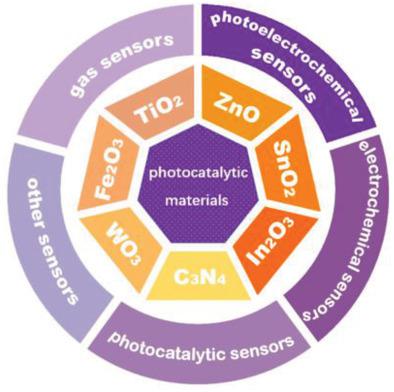当前位置:
X-MOL 学术
›
Adv. Mater. Technol.
›
论文详情
Our official English website, www.x-mol.net, welcomes your feedback! (Note: you will need to create a separate account there.)
Application of Photocatalytic Materials in Sensors
Advanced Materials Technologies ( IF 6.8 ) Pub Date : 2020-03-09 , DOI: 10.1002/admt.201900993 Xiaoyu Sun 1 , Chengyin Wang 1 , Dawei Su 2 , Guoxiu Wang 2 , Yunhao Zhong 1
Advanced Materials Technologies ( IF 6.8 ) Pub Date : 2020-03-09 , DOI: 10.1002/admt.201900993 Xiaoyu Sun 1 , Chengyin Wang 1 , Dawei Su 2 , Guoxiu Wang 2 , Yunhao Zhong 1
Affiliation

|
Photocatalysis technology can not only decompose water, toxic and harmful substances in the environment, but also directly convert solar energy into electricity and other clean energy. Therefore, the application of photocatalytic materials in sensors has great potential. The purpose of this paper is to review and discuss the application and potential of photocatalytic materials in sensors. The content includes the application of various photocatalytic materials in sensors. The photocatalytic materials mainly include n‐type semiconductor materials TiO2, ZnO, SnO2, Fe2O3, WO3, In2O3 and nonmetallic semiconductor C3N4. Sensors include gas sensors, photoelectrochemical sensors, electrochemical sensors, photocatalytic sensors, and other sensors. The results show that photocatalytic materials are most widely used in gas sensors. In addition to using photocatalytic materials to detect gas, the most common method is to use photocatalytic materials to detect the concentration of metal ions and organic substances in water. The most widely used photocatalytic material is titanium dioxide, and C3N4 as a nonmetallic semiconductor is rarely used in sensors. It can be concluded that photocatalytic materials have great potential in the application of sensors, among which C3N4 as a nonmetallic semiconductor photocatalytic material has more potential.
中文翻译:

光催化材料在传感器中的应用
光催化技术不仅可以分解环境中的水,有毒有害物质,还可以将太阳能直接转化为电能和其他清洁能源。因此,光催化材料在传感器中的应用具有很大的潜力。本文的目的是回顾和讨论光催化材料在传感器中的应用和潜力。内容包括各种光催化材料在传感器中的应用。光催化材料主要包括n型半导体材料TiO 2,ZnO,SnO 2,Fe 2 O 3,WO 3,In 2 O 3和非金属半导体C 3 N 4。。传感器包括气体传感器,光电化学传感器,电化学传感器,光催化传感器和其他传感器。结果表明,光催化材料在气体传感器中使用最广泛。除了使用光催化材料检测气体外,最常用的方法是使用光催化材料检测水中的金属离子和有机物质的浓度。最广泛使用的光催化材料是二氧化钛,而作为非金属半导体的C 3 N 4很少用于传感器中。可以得出结论,光催化材料在传感器的应用中具有很大的潜力,其中C 3 N 4作为非金属半导体光催化材料具有更大的潜力。
更新日期:2020-03-09
中文翻译:

光催化材料在传感器中的应用
光催化技术不仅可以分解环境中的水,有毒有害物质,还可以将太阳能直接转化为电能和其他清洁能源。因此,光催化材料在传感器中的应用具有很大的潜力。本文的目的是回顾和讨论光催化材料在传感器中的应用和潜力。内容包括各种光催化材料在传感器中的应用。光催化材料主要包括n型半导体材料TiO 2,ZnO,SnO 2,Fe 2 O 3,WO 3,In 2 O 3和非金属半导体C 3 N 4。。传感器包括气体传感器,光电化学传感器,电化学传感器,光催化传感器和其他传感器。结果表明,光催化材料在气体传感器中使用最广泛。除了使用光催化材料检测气体外,最常用的方法是使用光催化材料检测水中的金属离子和有机物质的浓度。最广泛使用的光催化材料是二氧化钛,而作为非金属半导体的C 3 N 4很少用于传感器中。可以得出结论,光催化材料在传感器的应用中具有很大的潜力,其中C 3 N 4作为非金属半导体光催化材料具有更大的潜力。


























 京公网安备 11010802027423号
京公网安备 11010802027423号